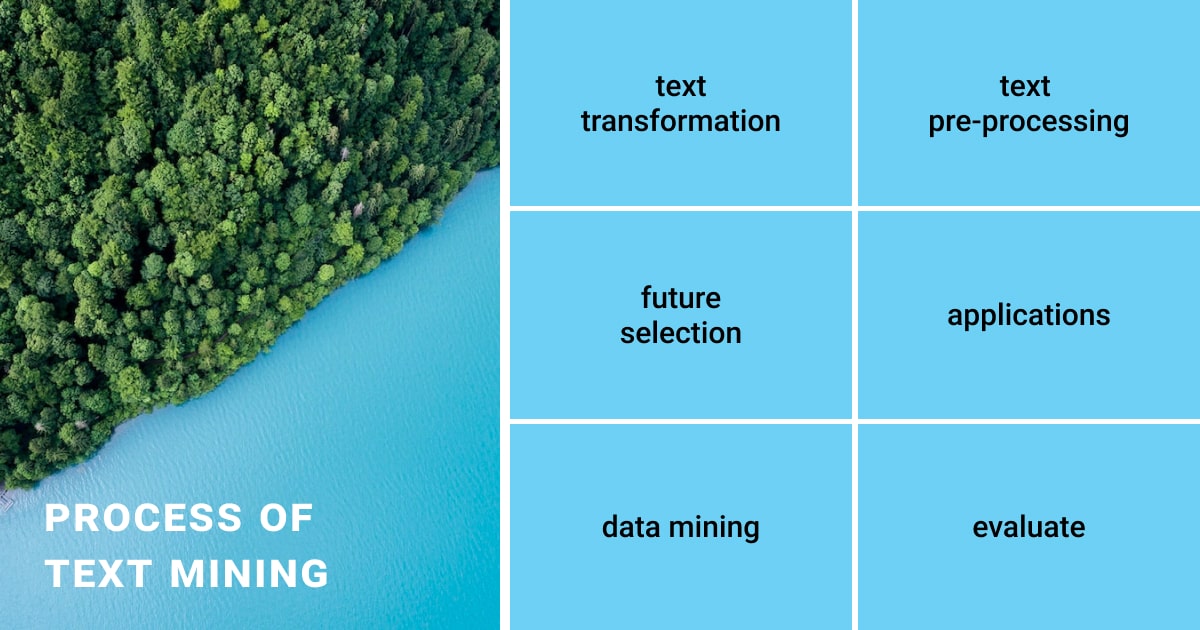Unstructured Text in Data Mining: Unlocking Valuable Insights in Document Processing
Table of Contents

As we approach 2025, more and more of the world’s data — a staggering 80% — will be unstructured. To stay ahead of the curve in the cutthroat business world, more than half of tech leaders have already started investing in unstructured data analytics. The strategic move can also help your company swiftly execute data initiatives and gain a coveted competitive edge.
Let’s face it: you deal with unstructured text data every single day. It’s your corporate emails, social media posts, reviews, chatbots, or customer service tickets. Analyzing this information manually can be time-consuming and inefficient, making it harder for you to make quick progress. So it’s no wonder that businesses like yours might struggle to make sense of an overwhelming amount of unstructured data.
But what if there was a way to unlock the valuable insights hidden in this data? That’s where data mining kicks in. With the insights gained from text data mining, you can address manufacturing or customer service issues promptly, anticipate potential competitive threats, and deliver personalized service, among other benefits.
Learn how data mining benefits businesses across industries in managing unstructured text data in this blog.
The Daunting Challenges of Analyzing Unstructured Text in Data Mining

In essence, data mining involves uncovering concealed patterns and insights from vast quantities of unprocessed, raw data. You can apply it to various types of data, including unstructured text data. It exists in various forms, such as emails, social media posts, news articles, and customer feedback.
Unstructured text in data mining is quite similar to OCR data extraction we’ve talked about a while ago. While both involve the analysis of textual data, the former focuses on analyzing unstructured data, whereas the latter helps convert unstructured data into structured data.
Despite its high value for business, unstructured text data is often underutilized due to its sheer size and complexity. Mastering data mining will eliminate this struggle and enable your business to make the text data work for you. But before delving into the details of the text mining process, let’s first address the potential challenges you may face along the way:
- Nature of unstructured data
Unstructured text in data mining lacks the structure and organization found in structured data, making it challenging to extract meaningful insights.
- Complexity of language and context
Text data can be complex and nuanced, with language and context that can be difficult to interpret without proper understanding of the domain and subject matter.
- Need for NLP techniques
To analyze raw text data, it often requires advanced natural language processing (NLP) techniques, such as sentiment analysis, topic modeling, and named entity recognition (NER), which can be complex and demand significant computational resources.
Addressing these challenges often requires a combination of data preprocessing techniques, machine learning algorithms, and domain-specific knowledge.
Preprocessing Unstructured Text in Data Mining
The preprocessing of unstructured text data is a crucial step in data mining. It involves transforming raw text data into a more structured format suitable for analysis using NLP. Let’s cover some key techniques used to preprocess unstructured text data:
- Text cleaning and normalization
This step involves removing irrelevant or unnecessary text such as HTML tags, special characters, punctuation, and numbers, and normalizing the remaining text by converting it to lowercase, removing stop words, and performing other techniques to standardize the text.
- Tokenization
Tokenization refers to the process of breaking down the normalized text into individual words or tokens. This step helps to standardize the text and make it easier to analyze.
- Part-of-speech tagging
Here, one assigns a part of speech to each token in the text, such as noun, verb, adjective, and adverb. This step is helpful for identifying the grammatical structure of the text and is used in many NLP applications.
- Named entity recognition (NER)
At this stage, one identifies and tags named entities such as people, organizations, locations, and other important information within the text. This step is useful for tasks such as information extraction and knowledge management.
These steps are typically performed in sequence and form the basis for many text mining and NLP applications. All in all, by preprocessing unstructured text, data mining practitioners can better analyze and extract insights from large volumes of text data, making it a key component in unstructured text analytics.
Text Mining Process: Key Techniques to Extract Meaningful Information from Unstructured Data

Text data mining is the process of uncovering insightful knowledge from large collections of unstructured text data. The text mining process involves several steps, each of which plays a crucial role in turning unstructured text data into structured and meaningful insights for various business purposes.
Based on NLP methods, text mining algorithms help organize a large amount of unstructured text by identifying the primary subject matter, purpose, and tone (whether it's positive, negative, or neutral). Once the text is analyzed, machine learning algorithms are applied to categorize the documents by the mentioned criteria.
This approach reveals patterns and correlations that would otherwise remain concealed within the text. Moreover, ML algorithms can create predictive models for anticipating new trends and patterns. Selecting the appropriate pre-set data model is crucial in ensuring the accuracy and relevance of the extracted information during the data mining process.
The text mining process typically involves:
- Collecting unstructured information from various sources in different document formats.
- Pre-processing and data cleansing to eliminate inconsistencies, including removing stop words stemming.
- Processing and cleaning techniques to further refine the dataset.
- Analyzing patterns through a Management Information System.
- Using the information gathered to extract valuable data for informed decision-making and trend analysis.
Besides, there are both basic and advanced techniques involved in the text mining process to derive meaning from textual content. The basic techniques focus on analyzing individual words or phrases within a document, which include:
- Word frequency analysis that defines the most widely used words and their synonyms.
- Collocation analysis helps determine the meaning of words that appear together frequently in a sentence or sequence.
- Concordance analysis defines the meaning of the words based on their context, considering that some of them may have multiple meanings.
Advanced text mining techniques take into account the context or themes across multiple documents. They are:
- Text classification identifies the document’s theme, intent, and sentiment.
- Topic analysis helps identify the main subject or theme of the document.
- Sentiment analysis detects the emotion and feelings expressed in the document, such as positive, negative, or neutral.
- Language detection categorizes the document based on its language.
- Intent detection identifies the document’s purpose, such as whether a client wants to buy a product or find out more information before making a purchase.
- Text extraction picks out important data within the document, while keyword extraction identifies the most common or significant words in the text.
- Named entity recognition (NER) extracts names of people, organizations, products, or locations, which can be useful for tracking online conversations about your products or competitors.
- Feature recognition extracts product features or customer information, like contact information.
- Multi-document analysis identifies trends and patterns across different documents, while clustering helps to group documents based on common characteristics.
- Co-occurrence identifies occurrences of the same terms in different documents, which can reveal potential issues or trends.
- Finally, trend analysis examines variations in topics or how they are treated in different time periods to see if new topics emerge and if some disappear.
Tools and Platforms for Unstructured Text Mining

As a matter of fact, analyzing unstructured text in data mining is a complex task that involves dealing with natural language and extracting insights from the vast amount of information. Luckily, there are various tools and platforms available that can help you with unstructured text mining.
- Natural language processing libraries (e.g., NLTK, spaCy)
NLP libraries like NLTK and spaCy are widely used for text mining tasks. They offer a range of functions for text preprocessing, part-of-speech tagging, named entity recognition, sentiment analysis, and more.
- Machine learning frameworks (e.g., Scikit-learn, TensorFlow)
ML frameworks like Scikit-learn and TensorFlow are also popular in text mining. These frameworks enable you to build and train custom models that can classify, cluster, or predict text data. With a vast number of text mining algorithms to choose from, you can tailor your model to your specific needs and achieve accurate results.
- Cloud-based services (e.g., Amazon Comprehend, Google Cloud Natural Language)
Amazon Comprehend and Google Cloud Natural Language are also valuable tools for text mining. They provide a range of text analytics features such as entity recognition, sentiment analysis, topic modeling, and more. Besides, cloud-based services offer a cost-effective way to analyze large volumes of text data and scale up as needed.
The tools and platforms for unstructured text analytics are constantly evolving and expanding, providing new opportunities for businesses and researchers to analyze their data. By leveraging these tools, you can make data-driven decisions that drive your business forward.
Top 7 Applications of Text Mining For Unstructured Document Data

Businesses across a wide range of sectors can employ text mining. A single company may have several uses for text mining, including enhancing customer interactions, lowering risk, fine-tuning production, examining the competition, and tracking staff happiness.
Let’s discuss each example of text mining in more detail:
- Customer feedback analysis
By analyzing customer feedback from various sources such as social media, review websites, and customer support tickets, businesses can better understand their customer preferences, pain points, and overall satisfaction. This information can be used to upgrade products and services, identify areas for improvement, and enhance customer experience.
- Brand monitoring and reputation management
Another example of text mining application is brand monitoring and reputation management. By monitoring social media, news articles, and other sources where the brand was mentioned, companies can identify potential hazards and take proactive measures to address them.
- Fraud detection and prevention
The knowledge derived from large volumes of text data, such as financial transactions, insurance claims, and legal documents, can help businesses identify anomalies that may indicate fraudulent activity. This can help prevent financial losses and protect against reputational damage.
- Content recommendation and personalization
Knowing how to analyze user behavior and preferences can open new doors for businesses. They can recommend products, services, and content tailored specifically to individual users. This boosts engagement, improves customer experience, and drives sales as a result.
- Manufacturing and product development
Text mining can be used to analyze customer feedback, product reviews, and other sources of unstructured data to identify areas for product improvement and innovation. This can help businesses stay ahead of the competition and meet evolving customer needs.
- Email filtering
No less important example of text and data mining is the analysis of the emails’ content to identify spam and other malicious content. This way, organizations can protect against cyber threats and ensure that employees are only receiving relevant and safe information.
- Competitive marketing analysis
Text mining can be used to analyze competitors’ websites, social media profiles, and other sources of online content to identify key trends and opportunities. This can help businesses develop more effective marketing strategies and stay ahead of the competition.
Whether it’s analyzing customer feedback, text files, text messages, or phone transcripts, businesses can use data mining to gain a competitive edge and improve overall performance.
Wrapping Up

Text mining proves to be a powerful tool that relies on natural language processing and other machine learning methods to reveal patterns and relationships in raw and unstructured text data. It has various applications across different fields, including CRM, marketing, sales, manufacturing, and IT.
Unstructured text analytics with data mining helps these businesses (including yours) identify critical information and respond promptly to challenges, anticipate threats, and provide personalized experiences to their clients. Thus, with the ever-growing flood of text-based sources, text mining is your best bet to stay competitive and maintain growth.
FAQ
What is text data mining in computer science?
The text mining process implies extracting meaningful information from unstructured text data, typically through the use of NLP techniques such as text classification, entity recognition, and sentiment analysis.
How can businesses benefit from unstructured data mining?
By analyzing and extracting insights from non-tabular data sources such as customer information, product catalogs, and financial records, businesses can gain valuable insights into customer behavior, market trends, and operational efficiency, among others.
What are some techniques that can be used to convert unstructured data into structured data?
Techniques such as natural language processing and machine learning algorithms can be used to convert unstructured data into structured data.
Written by
Karyna is the CEO of Label Your Data, a company specializing in data labeling solutions for machine learning projects. With a strong background in machine learning, she frequently collaborates with editors to share her expertise through articles, whitepapers, and presentations.

